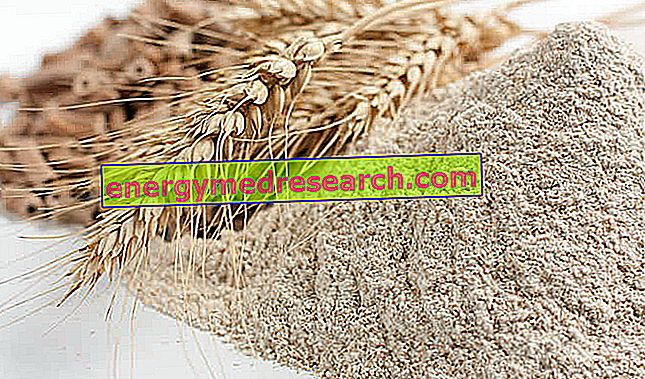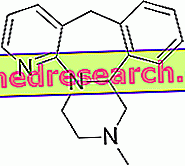What's this ?
Whole wheat flour is a food product obtained from the milling of soft wheat kernels ( Triticum aestivum ), previously released from foreign substances and impurities.
The whole wheat flour has a powdery consistency and is aimed at mixing with liquid and / or fat ingredients (water, oil or eggs), to give rise to many mixtures of typically Mediterranean origin (such as bread and pasta).

Homemade Whole Grain Bread Video Recipe
Homemade Whole Wheat Pasta Recipe Video
All Video Recipes with Whole Wheat Flour
Whole wheat flour should be obtained by grinding or crushing whole wheat seed; however, due to technical issues, it is often obtained from refined grains and subsequently added to bran.
NON integral flour is also called white flour; this, depending on the commercial destination, as well as being deprived of chaff or husk (bran), can be subjected to bleaching with food additives (bleaching agents). On the other hand, these refining processes tend to sacrifice one or more nutritional components of the food. To attempt to restore (at least in part) the original chemical characteristics, it is possible to mix the white flours with the integral flours.
The word "integral" refers to the fact that all the components of the seed are used, while the white flour is limited to the starchy endosperm.
In wheat, as in rye - but unlike rice, oats and spelled - the external integuments and the germ do not naturally remain attached to the caryopsis and are separated during threshing. On the contrary, in the other cereals, the glumella and the embryo adhere firmly and, for a possible refining, they must be excluded with a process called hulling.
Nutritional Features
The wholemeal flour is a complete flour which, in addition to starch, brings greater quantities of fiber than protein, white (medium biological value), vitamins (water-soluble and fat-soluble), fatty acids (mainly unsaturated - polyunsaturated) and ashes (mineral salts ).
The wholemeal flour is therefore more nutritious than the white one, although the latter can be enriched again with certain nutrients (micronutrients); the process is called fortification and, in some jurisdictions, is imposed by law
However, fortified white flour does not contain the same nutritional components and the same nutrients (macronutrients) as bran and wheat germ, especially as regards fiber, proteins and fats.
The whole grain of wheat and the wholemeal flour made from it are a good source of:
- fibers
- Calcium and iron (but with poor bioavailability)
- Magnesium and Selenium
- Water-soluble B vitamins (in addition to thiamine or B1 of white flour, also niacin or PP, pantothenic acid or B5 and pyridoxine or B6)
- Fat-soluble vitamins E (tocopherols) and retinol equivalents (pro vit A)
- Essential fatty acids (omega 3 group)
Health Impact
| Nutritional composition for 100g of whole wheat flour | ||||||||||||||||||||||||||||||||||||||||||||||||||||||||||||||||||||||||||||||||||||||||||||||||||
 | ||||||||||||||||||||||||||||||||||||||||||||||||||||||||||||||||||||||||||||||||||||||||||||||||||
Nutritional values (per 100 g of edible portion) | ||||||||||||||||||||||||||||||||||||||||||||||||||||||||||||||||||||||||||||||||||||||||||||||||||
| ||||||||||||||||||||||||||||||||||||||||||||||||||||||||||||||||||||||||||||||||||||||||||||||||||
Whole wheat flour is a vegetable ingredient belonging to the III group of foods, which in the human diet has the function of covering the need for carbohydrates, fiber, some salts and vitamins. Compared to the refined one, whole wheat flour provides less carbohydrates and calories, but higher doses than any other nutrient.
Carbohydrates are the molecules mainly involved in the production of ATP of cellular respiration, which is why whole wheat flour has a remarkable energizing power.
The fibers of whole wheat flour are mainly insoluble, but they also contribute to modulating intestinal absorption by reducing the uptake of fat (including cholesterol) and moderating the overall insulin index. Furthermore, the fibers feed physiological bacteria (prebiotic function) which act as a defensive immune barrier and produce certain vitamins. The fibers increase the sense of satiety and are related to a lower caloric intake, limiting the possibility of weight gain. They also promote intestinal peristalsis and the regularization of faecal evacuations, preventing constipation, haemorrhoids, fissures, tumors and many other intestinal pathologies or acute disorders. On the other hand, an excess of whole wheat flour (which can occur in the diet of athletes) would lead to malabsorption, diarrhea and meteorism.
Whole wheat flour also contains a higher dose of phytic acid, which helps reduce the uptake of certain minerals.
Among the electrolytes of whole wheat flour, the most important are certainly magnesium (very important for muscle contraction) and selenium (antioxidant and supportive of thyroid function). Iron and calcium, however well present, can be introduced more effectively by eating other foods of animal origin.
As anticipated, the most important water-soluble vitamins of whole wheat flour are B1, PP, B5 and B6, all coenzymatic agents of great metabolic importance. Vit E, also present, is a powerful antioxidant.
Wholemeal flour also contains a fraction of proteins, although of medium biological value. These, which do not have a complete amino acid profile for humans, can be completed by associating them with those contained in legumes.
The percentage of polyunsaturated fatty acids is also good, even if the whole wheat flour is certainly not the most suitable food to reach the recommended ration of these nutrients in the diet (made mainly from oil seeds, fishery products, oils, etc.).
For sedentary subjects, the substitution of refined flour with wholemeal flour represents a preventive element towards overweight and metabolic diseases, including type 2 diabetes mellitus and hypertriglyceridemia.
Whole wheat flour contains gluten and does not lend itself to dieting against celiac disease.
Video Recipes with Whole Wheat Flour
Conservation and Rancidity
The whole wheat flour has a shorter shelf-life than the white one.
The agent responsible for this negative characteristic is the prevailing lipid fraction (triglyceride fatty acids), which easily rancidizes (oxidation and peroxidation) due to the presence of: oxygen, light, water, acid pH, high or medium temperatures and certain microorganisms .
To be sure, not all fatty acids have the same chemical and physical characteristics; there are more or less resistant to high temperatures, light, oxygen, etc. Unfortunately, those of whole wheat flour, mainly contained in the seed or embryo of the seed, are considered among the most delicate in nature. Biologically, fatty acids are protected by certain elements called antioxidants. There are many types of them and everyone intervenes differently; the most important ones are probably the tocopherols or tocotrienols, or vit E. This acts "sacrificing" itself to keep the chains of fatty acids intact, which is why it is the first nutrient to be annihilated with rancidity. The process vaguely resembles tissue aging, which is why vitamin E is also considered one of the most powerful antioxidants and anti-aging molecules known to date.
The fatty acids of wholemeal flour are chemically defined as polyunsaturated and some of them are considered essential for humans (ie, the organism is not able to produce them independently). The "nutritional value" of whole wheat flour is therefore inversely proportional to its conservation and, despite the significant presence of tocopherols, the tendency to deteriorate remains very high.
To guarantee a good content of tocotrienols and essential fatty acids in whole wheat flour, it is therefore necessary to respect the following conservation requirements: low temperature, absence of light, hermetic sealing (better if partially vacuum-packed), low humidity, no contamination with other products and absence of significant microbial charges.
Whole wheat flour and bread
Often, whole wheat flour is not used as the main ingredient of baked goods due to its "heaviness" (specific weight) and less tendency to rise.
By increasing the quantity of whole wheat flour for the same volume of product (the air bubbles in the bread are smaller in number and size) the final yield is compromised, raising the processing costs. This is the reason why many baked foods theoretically "whole" are not produced with 100% wholemeal flour, but with the prevalence over refined (51% and 49%). Moreover, for a certain period of time, the "real" whole wheat flour was completely abandoned by the production cycles and the one available on the market was nothing but white flour added in bran.
On the other hand, it is possible to improve the yield of whole wheat flour by increasing the water content in the dough, since bran and germ also tend to absorb liquids. This can be achieved by mixing and working the dough for a longer period of time, further favoring the development of the glutinous lattice (necessary for leavening).
To optimize the process, some technicians adopt an additional leavening, so three in total: two for the dough and a third after giving it the shape. The addition of fats (butter, oil, lard) and / or dairy products (fresh milk, powdered milk, kefir, buttermilk, yogurt, etc.) can increase the volume of the food, depending on the type of ingredient and its percentage in the mixture.
Integral Pizza (Long Rising)
X Problems with video playback? Reload from YouTube Go to Video Page Go to Video Recipes Section Watch the video on youtubeWhole Wheat Flour
The whole white flour is (or should be) a flour ground from whole seeds of durum wheat. The paler color is justifiable by the fact that the ears are harvested in spring, unlike the traditional red or golden wheat that respects a typically summer production cycle.
The substantial difference between the two products lies in the fact that the integral white flour has a lower content of: gluten, tannins and phenolic acid. The taste is obviously lighter and more delicate, similar to that of refined flour. A commercial example of whole white flour is the "King Arthur White Whole Wheat Flour".
In Italy, on the other hand, a type of whole white flour is artificially obtained by enzymatic biocatalysis (a biological process) of traditional wheat bran. It is a technique patented by the Integalbianco® brand, which acts on increasing the solubility of otherwise insoluble fibers (up to + 20%) making them more available to the human organism.
Tendency to Consumption
Although the general population has always preferred white to whole wheat, recently, the consumption of foods rich in fiber seems to be in great development. This is mainly due to the disclosure on the nutritional benefits of whole wheat flour, which have convinced consumers despite a small economic disadvantage.
The "Whole Grains Council Industry Association" reported almost a doubling of the production of whole wheat flour during the years 2003-2007. In the same period, in the USA, the consumption of wholemeal bread matched the white one and, starting from 2010, it even exceeded it.
Legislative outline
The commodity characteristics of whole wheat flour are regulated by current legislation, therefore potentially different between the various countries of the world.
In Italy, whole wheat flour is regulated by the Decree of the President of the Republic dated 9 February 2001, n. 187. Within the document the definitions and characteristics of wheat flours are specified, including the integral one:
Chapter I, Article 1, paragraph 1: The product obtained directly from the milling of soft wheat freed from foreign substances and impurities is called "whole wheat flour".
Chapter I, Article 1, paragraph 3: Chemical characteristics: Maximum humidity of 14.5%, a minimum of ashes equal to 1.30 on one hundred parts of dry matter, a maximum of 1.70 of ashes on one hundred parts of dry substance and a minimum protein portion (nitrogen x 5.70) of 12.00.
Chapter I, Article 2, paragraph 3: It is called "whole durum wheat semolina", or simply "whole wheat semolina", the sharp-edged granular product obtained directly from the grinding of durum wheat freed from foreign substances and impurities.
Chapter I, Article 2, paragraph 5: Chemical characteristics: Maximum humidity of 14.5%, a minimum of 1.36 of ash on one hundred parts of dry matter, a maximum of 1.70 of ashes on one hundred parts of dry substance and a minimum protein portion (nitrogen x 5.70) of 11.50.
In the United States, the "whole wheat flour" must contain the whole portion of bran, germ and endosperm, thus maintaining all natural proportions.
In Canada, on the other hand, the "whole wheat flour" can be reduced up to 5% of the seed and does not necessarily have to conserve all the natural chemical proportions. It can contain up to -70% of the original germ, making it much more conservable. However, the term "whole grain whole wheat flour" exists, which necessarily involves the use of whole grains with natural proportions (including the embryo).
In various countries of the world, whole wheat flour is marked by a name, an acronym, a wording or a specific number.
Summary table of the wordings on whole wheat flours in some countries of the world
| Ashes | Protein | Type of Wheat Flour | ||||
| US | UK | Germany | France | Italy | ||
| > 1.5% | ~ 13% | white whole wheat | wholemeal | 1600 | 150 | Wholemeal wheat flour |
| Czech republic | Poland | Argentine | Sweden | |||
| Celozrná mouka | graham, razowa | ½ 0 | graham | |||



